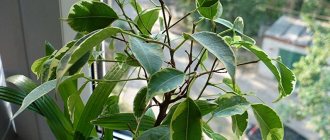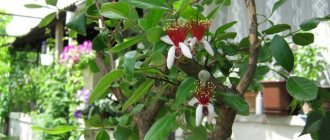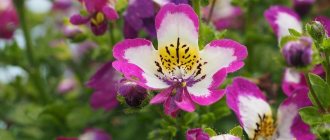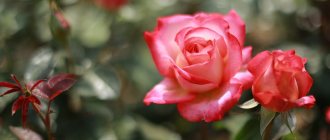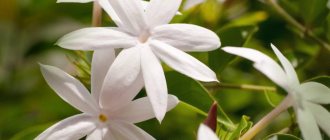From my own experience, I know that most gardeners involved in growing roses usually give preference to the usual climbing roses that adorn arches and pergolas, tirelessly blooming floribundas of all colors and shades, hybrid tea beauties with their exquisitely shaped flowers, and fragrant English novelties. Meanwhile, at this ball, somewhere on the sidelines, unpretentious “Cinderellas” were modestly hiding, which could also please the domestic gardener, but the hour of their triumph has not yet come. We are talking about hybrids united in a class Musk roses (Hybrid Musk)
, the charms and advantages of which we all have yet to appreciate.
Meanwhile, the history of their appearance began back in 1904, when the German gardener Peter Lambert produced a hybrid of multiflorous and noisette roses, called Trier. It was this white climbing rose that was destined to become the progenitor of all later varieties called musk. In particular, in 1936 Lambert registered Mozart
- one of the few varieties known to us at present.
EVERYTHING YOU NEED FOR THIS ARTICLE IS HERE >>>
This masterpiece of selection blooms continuously until frost with caps of white-pink, phlox-like flowers. A strong, spreading bush covered with small leaves that are resistant to black spot and tolerates partial shade.
Strictly speaking, participation in the process of hybridization of wild musk rose (Rose moschata)
not that big.
Breeders experimented more with representatives of other species: Rose multiflora, Rose Phenicia, Rose mulliganii, Kose. sempervirens, Rose arvensis, but ironically the resulting varieties were called musk hybrids.
UNMATCHED VARIETIES OF MUSK ROSES
Work on the hybridization of musk and noisette roses was also carried out by other breeders. Thus, in England, vicar Joseph Pemberton obtained varieties that remain unsurpassed to this day - Daphne (1912), Danae (1913), Pax (1918), Prosperity (1919), Vanity (1920), Penelope (1924), Cornelia (1925), Felicia (1926), Robin Hood (1927).
Pax
- a legendary rose of English selection, white semi-double with golden eyelashes of stamens. It is distinguished from other musk roses by its elegant creamy elongated buds on long stalks. There are up to 30 flowers in racemes. The dark green, glossy foliage beautifully sets off the pure white flowers. Young leaves and growth are dark crimson. Bush
spreading, flexible shoots up to 4 m long, which allows the variety to be cultivated on a support as a rambler.
Cornelia
— double, fragrant apricot flowers with a wavy edge bloom in large numbers on flexible, smooth shoots 150–175 cm long. The bush is fountain-shaped, wide, spreading (up to 120 cm). The spherical, red-coral buds together with the already blooming flowers are a breathtaking sight. The variety is surprisingly resistant to rain and partial shade.
Penelope
and now one of the most popular varieties of musk roses. The buds are pink, with a peach blush; flat, fragrant creamy-pink semi-double flowers with a diameter of 6 - 8 cm with lemon-yellow stamens and wavy edges are collected in loose inflorescences. The leaves are at first a rare plum-red hue, then become dark green and shiny. The variety is extremely unpretentious and tolerates both semi-their planting and poor soils.
Prosperity
- an old English variety with semi-double rosette-shaped flowers, white with pink “shadows”, very fragrant, collected in large inflorescences. Glossy foliage provides an excellent backdrop for flowers. The width of the bush reaches a meter.
Felicia
is rightly considered Pemberton's masterpiece. And how could it be otherwise, if this rose is the very best - beautiful and resilient, with long-lasting flowering!
Terry peach-pink very large, fragrant flowers, reminiscent of hybrid tea varieties, are collected in loose clusters, each with up to 50 pieces. The foliage is bright green, shiny, and in spring a bronze hue. The bush is powerful, spreading, up to 150 cm high and up to 250 cm wide, with arched shoots. In autumn it is covered with large red fruits. Decorative all season, from early spring to late autumn.
VARIETY BALLERINA
Ballerina in England in 1937
, blooming with round caps of simple, small pale pink flowers, somewhat reminiscent of apple trees.
This is one of the few roses among musk hybrids that is already familiar to Russian gardeners, and its popularity is growing year by year. Which is completely unsurprising
But this is a very reliable, fairly unpretentious and winter-hardy variety. In the clusters, the flowers open one at a time, changing color from bright pink, Barbie doll's favorite color, to pure white. The foliage is bright green, the stems are practically thornless. In autumn the bush is strewn with orange
fruits. The variety is distinguished by its extraordinary abundance and continuity of flowering. It blooms so much that the foliage is not visible. A group of several plants is a delightful sight, somewhat reminiscent of a ballerina's tutu. Good in mixed plantings and borders.
Subtleties of planting flowers
Musk roses are unpretentious flowers that do not require regular care. Therefore, the planting system and choice of location must be treated with special attention.
If agricultural practices are followed and the site is chosen successfully, the bush will require minimal work from the gardener in the future.
Roses of all varieties can be planted in early spring or autumn. Summer planting is practiced only for seedlings with a closed root system. Fragrant beauties love the sun, but they also feel great in shady places, the main thing is that the soil under the bush is not swampy. Stagnation of moisture at the roots adversely affects flowering.
See also
Description and characteristics of Robusta roses, details of planting and careRead
The depth of the planting hole is 60 centimeters; expanded clay drainage is installed at the bottom and fertilizers are added. At the base of the hole, make a small dense hill, along which the roots are carefully spread. The plant is sprinkled with basic soil, watered and compacted so that the root collar remains above the surface of the ground.
BEAUTY LOVER
Two years later, the couple received another wonderful variety - Buff Beauty
. An excellent representative of musk hybrids - one of the most widespread varieties in Europe. The length of graceful drooping shoots reaches 175 cm, the diameter of flowers is up to 10 cm. A spreading bush up to one and a half meters wide. The flowers are densely double, yellow-apricot, collected in large loose inflorescences with a rare apple-banana aroma. Wonderful large leaves - initially reddish, then dark green.
DELIGHTFUL STRANGERS
Nowadays, the Belgian nursery of Lens (Pepinieres Lens), created in 1870, is recognized as the undisputed leader in the hybridization of musk roses. Since the 50s of the 20th century, more than 100 varieties of musk roses have been obtained here (in total, about 800 varieties of this group are included in the world register ). In our country, unfortunately, all of them are still little known. Meanwhile, this nursery has bred amazing varieties: Heavenly Pink (1997), Dinky1 (2002), Jean Stephenne (2006), Guirlande dAmour1 (2008) and many others.
Jean Stephenne
- a vigorously growing healthy bush that produces, imagine, several thousand (!) flowers per season. The delicate salmon-colored buds open into semi-double creamy pink flowers. The bush has dense light green foliage and burgundy shoot tips.
Guirlande d'Amour
- a tall, upright variety that can be grown as a rambler, completely covered with delicate creamy-white flowers with yellow stamens, tolerates partial shade, and is resistant to rain.
Guirlande Rose -
variety, bred fifteen years later than the previous one, also a rambler up to 4 m tall, but with pink-cream flowers collected in luxurious inflorescence bouquets, with a light, unobtrusive pleasant aroma of cloves. The shoots are practically thornless. It is also disease resistant and tolerates a shady location.
Very special – Bouquet Parfait
, fully justifies its name, which translated from French means “excellent bouquet.”
Its dense spherical inflorescences, consisting of milky-white flowers with pink edges, are indeed like ready-made bouquets for the bride. There is its analogue with white flowers Neige dEte
, decorated with lush inflorescences of cup-shaped snow-white flowers with yellow stamens, which bloom all at the same time, forming spectacular bouquets. The variety is frost-resistant, good for cutting, the flowers are not at all afraid of rain.
Comparison with other hybrids
Musk roses compare favorably with classic and other hybrids in the type of flowering. The flowers are collected in clusters and bloom all together, forming a lush cloud.
The important thing is that roses bloom in waves, and the rest period between streams is relatively short. This is a “tidbit” for lovers who prefer continuous flowering.
None of the other types of roses can surpass the scent of these particular flowers. It is so strong that the presence of just one bush in the garden will “overwhelm” the aroma of any flowers. A floral aroma with notes of fruit and musk will fill every corner of the garden. An interesting detail is that it is the stamens that emit the smell, not the petals .
Let's look at the different types of roses:
| musky | Hybrid tea | Floribunda |
|
|
|
CREAM, PINK, RED ROSES
Other varieties stand out: Feeling
with creamy yellow buds, fragrant semi-double white flowers with a bunch of golden yellow stamens; excellent
Bukavu
- simple two-tone carmine-red flowers with a white center and wavy edges are collected in spectacular clusters that are not afraid of rain;
Magie dOrient
, similar to
Ballerina
, only the bush is taller and spreading, inflorescences of simple white-pink flowers hang elegantly on long shoots.
NEW GENERATION MUSK ROSES
Among the new products from the Lens nursery, we can recommend the new generation hybrid of musk roses Grand- Due
Jean
(2010) - a tall, erect variety with relatively large simple cherry-red flowers with a white bottom and long yellow stamens, blooming continuously from early summer to autumn. Brother flowers! in round bouquets.
Another interesting variety among the hybrids bred in recent years is Poppy
Rose
, it has simple flowers of a bright scarlet color, similar to a poppy, and dark brown young foliage, which makes the bush unusually elegant.
Other nurseries also have musky varieties: Cordes has Erfurt,
Lavender Lassie
, and Harkness
has Red Ballerina.
Main diseases and pests
Plants are not susceptible to the development of diseases and pest attacks. To reduce the likelihood of damage even further, you should strictly follow the rules of crop rotation and agricultural technology, and regularly irrigate the bushes with fungicidal and insecticidal preparations.
Musk roses are a real work of art that will become a bright decoration for any country house or garden plot. In comparison with its relatives, this variety is unpretentious in care and cultivation, which greatly facilitates the task of the gardener. Even a beginner can grow it, just read all the recommendations first.
MUSK ROSES FOR A SMALL GARDEN
Various originators have produced varieties with small dimensions, which allows them to be planted even in a small garden, in containers or on a balcony.
This is, for example, Schubert
its low bush (up to 80 cm) is perfect for a small garden.
Clusters of simple, non-double, cup-shaped, carmine-red flowers with a white “bottom” and bright yellow stamens do not fade for a long time. The leaves are elongated, dark green. Hybrid Robe Fleurie
- no more than half a meter high, flowers are simple, white and pink, reminiscent of apple trees.
Or a very tiny one from the “Seven Dwarfs” series - a compact bush Alberich
, only 30 - 40 cm high, decorated with small, semi-double red currant-colored flowers matching its habit and glossy dark green foliage.
This variety is recommended for balconies. Another miniature variety - Flash
, 50 cm high, with semi-double white, lightly blushed, fragrant flowers in pyramidal inflorescences.
MUSK ROSES IN GROUPS, FLOWER BEDS AND MORE
Few plants can create such a magnificent decorative effect as musk roses! Group plantings of the same variety in a row or in flower beds simply amaze with their abundant flowering. Placing in arrays allows you to create luxurious color spots. It should be noted that in Western European countries musk roses are widely used in urban landscaping - this is another evidence of their unpretentiousness.
In addition, no one has canceled the planting of musk hybrids in rose gardens, next to traditional large-flowered varieties. Their presence will only emphasize the grace of hybrid tea roses, the bright beauty of floribundas and complement the decorative effect of scrubs.
Here you just need to try not to make a mistake with color combinations: plant either in a monochrome palette, color to color, or according to the principle of contrast. And in the period between the first and second waves of flowering, when almost all roses take a break, planting continuously flowering musk hybrids will be most opportune.
The only condition is that they need to be left enough space to “grow”, given their spreading shape. Fragrant varieties are given a place next to benches and gazebos.
Musk roses are also good in the background of flower beds.
They are used in combined plantings together with decorative deciduous shrubs - barberries, of which there are a great many variations, bladderworts, derains and spirea. The best companions among perennials are clematis allifolia, various varieties of geraniums, Fassin's catnip, and sage. Hybrids with long shoots 2.5 - 4 m, as already mentioned, can be grown as climbing ramblers, decorating arches, columns and pyramids with them. Many varieties are suitable for decorative hedges.
Thanks to the simple flower form and casual spreading form of the bush, varieties with simple flowers are good in gardens and natural style compositions, where they are planted among grasses.
In short, I strongly advise you to take a closer look at musky hybrids. Considering the abundance of assortment, with their help you can achieve stunning decorative results with little effort. Plant a couple of musk hybrids - the result will exceed all your expectations!
History of selection
At the beginning of the 20th century, Peter Lambert (a breeder from Germany) developed “Trier”, a variety that became the first to belong to musk roses. The result of the selection not only shocked ordinary flower growers, but also impressed specialists. Lambert developed a very fragrant, profusely (and repeatedly) blooming rose. Other breeders also began developing new varieties. For example, Lambert’s assistants, the Bentall spouses, created the “ballerina” variety, Joseph Pemberton (England) became the author of such varieties as “Cornelia”, “Penelope”, the huge Lens Rosen nursery was opened by Louis Lenay (Belgium) where they have been growing for many years and develop new varieties of magnificent aromatic plants. Musk roses are the name of a fairly wide range of hybrids, such as:
- phoenecia,
- moschata;
- mulliganii;
- arvensis;
- multiflora;
- sempervirens.
In search of musk
Do not think that these roses received their name for the delicate aroma inherited from the musk rose species
. Not all of them emit the smell of musk, a substance secreted by the glands of some animals, such as musk deer or beaver.
According to experts, in concentrated form it is rather harsh and unpleasant. It’s just that musk in microdoses is used in the manufacture of perfumes, and the aroma of wild musk rose rather evokes some kind of perfume associations. The paradox is that many of the later hybrids cannot boast of an aroma, and some of them even smell not of musk, but of apples or bananas. But this is so, notes in the margins for those who will unsuccessfully search for that very notorious smell of musk.
ADVANTAGES OF MUSK ROSES
Musk roses began to appear at exhibitions quite recently. I remember the surprise of visitors to one of them when they first saw the lush inflorescences of the ' Mozart'
, similar to phlox caps. I also have to reassure my garden guests every time that this is a rose and not a phlox!
Meanwhile, musk roses have many advantages compared to traditional roses.
They are distinguished by fast growth and continuous flowering. All of them are famous for their excellent health, many have glossy foliage that is immune to disease. Their main feature is that musk hybrids bloom almost all summer, from June until frost. But they bloom not just, but unusually profusely, forming bushes that literally look like snowdrifts. This is due to the characteristics of flowering. This happens without interruption - such a perpetuum mobile of beauty, and the flowers bloom almost simultaneously.
Most varieties of musk roses tolerate light partial shade. Their shoots are flexible and easy to hide in a winter shelter. Yes, they have practically no drawbacks, except that most require quite a lot of space due to the fact that they have a wide, spreading shape and long arched drooping shoots.
What it is?
Musk roses are fairly large fountain-shaped bushes that bloom at the ends of arched shoots.
This variety includes several species of different shapes, colors and bush heights. Musk rose is a favorite of landscape designers. This is due to the fact that it looks best from a distance and fits well into large-scale compositions, for which it received an additional name - “Landscape”.
Musk roses have these characteristics:
- hardy;
- resistant to temperature changes;
- frost-resistant.
The vast majority are large, oversized plants, reaching 2 m in height. They need support, but if there is none, the shoots partially fall down and the bush grows in breadth.
Separately, it is worth mentioning about flowering. First, buds appear on the tops emerging from the base of the basal shoots, and only after the top has partially flowered do new buds appear on the lateral shoots. There are much more lateral shoots than basal shoots, so from the outside it seems that the bush is covered with flowers. This is a period of mass flowering and will last quite a long time.
The aroma of musk rose flowers is quite strong and pleasant , but not all representatives of this group have this quality. Unfortunately, the most beautiful varieties exude a very weak aroma, or even have none at all.
FEATURES OF PRUNING MUSK ROSES
I would like to warn you that all musk roses do not tolerate heavy pruning! High pruning promotes early flowering. Otherwise - with low pruning - they, although they quickly grow back, will bloom only by mid-summer. Formative pruning consists of removing inflorescences that fade in summer in order to stimulate the growth of new flowering shoots. Thanks to this, the repeated wave of flowering will be stronger. This should be practiced until mid-September, and then let the rose form fruits; in some varieties they are very pretty, similar to bright cherries.
In the spring, in the third year after planting, biennial shoots are cut to the ground. This technique promotes the emergence of new basal skeletal branches. And this must be done annually, removing old branches into the ring. That, in fact, is all the wisdom with pruning. It should be noted that all musk roses have excellent regenerating ability.
© Author: NATALIA GNATOVSKAYA, experienced rose grower
ORDER QUALITY AND CHEAP SEEDS AND OTHER GOODS FOR YOUR HOME AND GARDEN. PRICES ARE PRICEY. CHECKED! JUST LOOK FOR YOURSELF AND BE SURPRISED. THERE ARE REVIEWS. GO>>>
Below are other entries on the topic “Do-it-yourself cottage and garden”
- Musk hybrid roses (photo) varieties and care: Growing musk hybrid roses History of musk roses…
- Roses of the Explorer series: Explorer - a series of roses: winter-hardy...
- How to plant roses correctly - a master class from a PROFESSIONAL: CORRECT PLANTING OF ROSES What could happen...
- Roses from seeds - step-by-step instructions from a florist: PROPAGATION OF ROSES BY SEEDS I sow rose seeds...
- Spray roses (bouquet) names and descriptions of varieties: SPRAY ROSES: GROWING AND CARE…
- Canadian park roses - varieties, care and cultivation in the flower garden: For those gardeners who consider...
- 4 main stages of caring for roses in June: CARE FOR ROSES IN JUNE 1….
Subscribe to updates in our groups and share.
Care Tips
After planting, water and hill up the bush. Always ensure that the soil near the musk rose is moist. This is especially important in the first year of life, when the plant is just taking root. Mulching with humus or grass clippings helps retain moisture. Mulch will protect the plant from drying out. Musk roses hardly get sick and are not affected by pests. When signs of powdery mildew appear, treat with fungicides.
If the leaves are infested by caterpillars, and the tender buds are infested by aphids, insecticides are used.
Musk roses are pruned very carefully. If necessary, remove up to a third of the length of the branches. But it is better not to carry out any circumcision other than sanitary. Only broken, weak and diseased branches are removed. The buds of young bushes need to be cut off after planting. This will help the rose take root faster.
After flowering, the rose may begin to bear fruit. They are the same as those of wild rose hips. You can leave them on the bush. This will decorate it for a few more months. If you need to get as many flowers as possible, the fruits are picked off.
